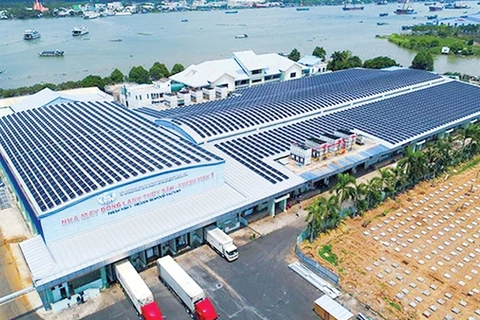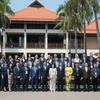 Delegates at the GECF & ERIA Joint Workshop on prospect of a natural gas market in the EAS region. (Photo: eria.org)
Delegates at the GECF & ERIA Joint Workshop on prospect of a natural gas market in the EAS region. (Photo: eria.org) Jakarta (VNA) – ASEAN will more than double its natural gas demand to 350 billion cubic metres by 2050 as the region shifts away from coal-fired power generation, according to the Gas Exporting Countries Forum (GECF).
Natural gas demand in ASEAN is expected to rise to 350 billion cu.m over the next three decades, GECF Secretary-General Mohammed Hammel said a forum held by the GECF in collaboration with the Economic Research Institute for ASEAN and East Asia (ERIA) in Jakarta on February 21.
The region’s share of natural gas in its energy mix is projected to consistently grow to 24 percent by 2050, he added.
GECF data showed ASEAN's natural gas demand stood at 160 billion cu.m in 2021, including 80 billion cu.m for power generation and 50 billion cu.m used by the industry sector.
These two sectors will continue to take the lion’s share of the bloc's natural gas demand in 2050. Indonesia, Thailand, and Malaysia also become the largest contributors to the demand.
According to the GECF, ASEAN is still heavily reliant on coal. The combustible black rock represented 24 percent of the region’s energy mix in 2021, but will likely drop to 13 percent in 2050 as the share of cleaner energies grows.
The GECF reported that Thailand was the largest importer of liquefied natural gas (LNG), and will maintain its position over the next decades. ASEAN's natural gas production will continue to be around 180 billion cu.m in 2050, and the region primarily extracts its gas offshore.
Hammel stressed that in the ASEAN region, switching from coal to gas is the low-hanging fruit to improve air quality and reduce greenhouse gas emissions. Natural gas is a partner of renewables, providing backup and stability to power grids.
The GECF revealed if coupled with carbon capture and storage (CCS) technology, natural gas could abate an additional 735 million tons of carbon dioxide emissions just in the power sector alone by 2050.
Hidetoshi Nishimura, the president of the think-tank ERIA, said natural gas can reduce emission via its expanded use in the initial stage of the clean energy transition from 2020 to 2030 by applying existing and affordable fuels, as well as energy technologies. In the longer term of 2030-2050, many advanced technologies such as co-firing with hydrogen and CCUS (carbon capture, usage, and storage) will be deployed.
So far, many ASEAN countries have announced their carbon emission neutrality target, including Indonesia, Malaysia, Thailand, and Vietnam./.






















